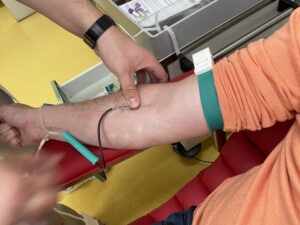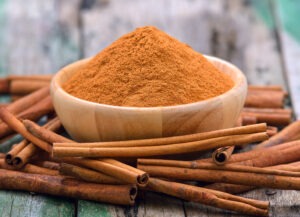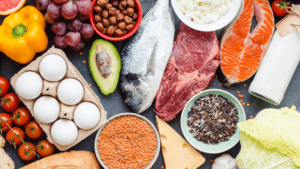“I’m still hungry!” “I can’t stop eating!” “I hate feeling ‘hangry’!”
When we have not eaten in a little while–or when the foods we eat do not satisfy our appetites–it becomes difficult to think about anything other than food. Food odors, advertisements, restaurants, visions of food, our minds turn repeatedly towards these stimuli. This can compromise our ability to focus on other important tasks or goals (Sam, 2018).
For those struggling with overweight or obesity and trying to lose weight, the appetite fueling food obsessions only worsens (Hall & Kahan, 2018). Our hunger hormones surge as our body tries to reclaim any weight that was lost (Hall & Kahan, 2018).
The increase in hunger both during and after weight loss is a major reason behind the infamous weight regain (Hall & Kahan, 2018). In spite of our efforts to exert willpower and self-discipline, little by little portions increase. “Slip-ups” are increasingly common.
Before we know it, our hard work losing weight has been undone. But…does it have to be this way?
Are we helpless subjects to the whims of forces within ourselves beyond our control? Or are there ways to quash hunger without sabotaging our health goals?
While the drive to eat can be brought on by reasons other than hunger (such as boredom, pursuit of pleasure, or responses to stressors and emotions), this article focuses on the best foods to eat according to research for satisfying sensations of actual hunger.
What foods can best satisfy our hunger?
An oft cited study from the European Journal of Clinical Nutrition (1995) tested 38 different foods grouped in 6 categories using the research validated satiety index scale. The purpose was to determine which common foods are the most filling/ which foods promoted the greatest satiety after consumption when matched calorie for calorie (Holt et al., 1995).
Each food was served to participants at a 240 calorie total serving size. Satiety was measured every 15 minutes for the next 2 hours after consuming a particular food (Holt et al., 1995).
The tested foods were categorized as follows:
- Baked goods (cookies, crackers, croissants, donuts, etc)
- Snacks (potato chips, candy bar, peanuts, pop corn, jelly beans)
- Breakfast cereals with milk (muesli, oatmeal (porridge), cornflakes, bran cereal, etc)
- Protein rich: (lentils, cheese, eggs, baked beans, steak, fish)
- Carbohydrate rich: (french fries, white pasta, whole grain pasta, white rice, brown rice, white bread, whole grain bread, etc)
- Fruits: (bananas, grapes, apples, oranges)
The most hunger satisfying foods were?
Using white bread for the comparison, with a satiety index score of 100, the most filling food category when averaged out of the above list was shockingly…FRUIT!!!–with an average satiety score of 170 (Holt et al., 1995)..
While surprising at first, more recent research on satiety hormones notes that polyphenols in fruit may both promote higher satiety hormone levels and increase the amount of time it takes to break these hormones down in the body (Klementova et al., 2019).
The average satiety score for the categories were as follows (higher is better):
- Fruit (category average score: 170)
- Carbohydrates and Protein categories were tied (average scores: 166)
- Breakfast cereals with milk (average score: 134)
- Snacks (average score: 100, same as white bread!)
- Baked goods (average score: 88, worse than white bread!!)
Amongst the individual foods tested, the top foods were in order:
- Boiled potato, and by a long shot! (satiety score: 323!!!!!)
- White fish (satiety score: 225)
- Oatmeal (satiety score: 209)
- Oranges (satiety score: 202)
- Apples (satiety score: 197)
- Whole grain pasta (satiety score: 188)
- Beef steak (satiety score: 176)
- Baked beans (satiety score: 168)
- Whole grain bread (satiety score: 157)
- Bran cereal (satiety score: 151)
- Eggs (satiety score: 150)
Some of the worst foods for promoting satiety?
- Croissants (satiety score: 47!! Compared to white bread’s score of 100!)
- Cake (satiety score: 65)
- Doughnuts (satiety score: 68)
- Candy bar (satiety score: 77)
Some surprises in terms of lower than expected satiety scores?
- Peanuts (satiety score 84? Compared to white bread’s score of 100!)
- Yogurt (satiety score 88)
While these results may be surprising, it makes a little more sense when we look at current research findings on fat (peanuts are calorie dense with high percentages of fat) and the research on simple carbs (as noted with white bread, added sugars in the case of yogurt) as they relate to satiety.
What is more hunger satisfying? Protein? Carbs? Fat?
All 3 are necessary for optimal health, but which help satisfy your cravings the most?
From a macro nutritional perspective (protein, carbohydrates, fat), research has found that when matched calorie for calorie (Tremblay & Bellisle, 2015):
- Protein is more filling than carbohydrates or fat.
- Carbohydrates are more filling than fat, but less filling than protein.
- Fat is the least filling of the three macronutrients when compared calorie for calorie to protein and carbohydrates.
While research notes that protein is the most filling of the macronutrients, proper nutrition assures balance between carbs, protein, and fat. A truly balanced diet is made up of (dietaryguidelines.gov, 2020-2025):
10-30% protein
45-65% carbohydrates
25-35% fat (these are typically found naturally in protein, grain, and vegetable sources without adding oil).
For example, it must be noted that “low carbohydrate diets” with a carbohydrate intake of less than 40% of daily caloric intake have been associated with higher mortality rates according to the Lancet Public Health Journal (Seidelmann et al., 2018).
Meals with high carbohydrate content have been shown to decrease ghrelin (a powerful hunger stimulating hormone) levels to a degree superior to when there are high levels of fat consumption (Tremblay & Bellisle, 2015).
Therefore, achieving optimal health and weight outcomes means eating a varied selection of lean proteins and healthy complex carbohydrate sources. Dietary fats can actually promote increased eating/ increased total calorie consumption due to flavor and aroma enhancing effects–this in addition to fat being a more calorie dense nutrient (Tremblay & Bellisle, 2015).
It should be noted that alcoholic beverages do nothing to promote satiety, and thus represent empty additional calories when consumed (Tremblay & Bellisle, 2015).
Are plant-based foods more hunger satisfying than meat and cheese based foods when matched for protein, carbohydrate, fat, and calorie content?
In an interesting randomized controlled crossover study with obese participants with diabetes, without diabetes, and a normal weight control group, researchers found a plant-based tofu burger was more filling than a calorie, carbohydrate, fat, and protein matched hamburger with cheese (Klementova et al., 2019).
When participants ate the plant-based burger, regardless of whether they were obese, diabetic, or healthy weight, they experienced significantly higher blood levels of satiety hormones GLP-1 (the same hormone that is mimicked by Ozempic, Wygovy (semaglutide) and Mounjaro (tirzepatide), amylin, and peptide YY compared to when they ate the hamburger with cheese (Klementova et al., 2019).
Not only that, participants reported feeling more satisfied/ satiated after eating the plant-based burger compared to after eating the hamburger with cheese (Klementova et al., 2019).
So better satiety hormone response and feeling more full after eating a plant-based meal, seems like a win. Why is this?
Fiber (only found in plant-based foods) contributes bulk and volume to plant-based foods and as already noted above, polyphenols found in plants appear to raise satiety hormone levels and enhance the length of time these hormones stay elevated (Klementova et al., 2019).
Can vitamins and minerals affect our hunger?
Research indicates that certain vitamins and minerals may play a role in promoting satiety (Tremblay & Bellisle, 2015).
For example, in obese persons who consumed insufficient dietary calcium, supplementation increased the appetite suppressing hormone PYY (Tremblay & Bellisle, 2015). However, calcium supplements may increase the risk of calcification (hardening) of the arteries along with other health concerns related to supplementation (John Hopkins Medicine, 2023).
Food sources of calcium are much better options and include:
- Dark leafy greens like kale and spinach
- White beans and garbanzo beans
- Soybeans
- Almonds
- Low fat dairy
Research has also noted improvements in appetite on participants in a weight loss study when they took a multivitamin versus a placebo (Tremblay & Bellisle, 2015). It is possible that deficiencies in micronutrients may drive appetite increases to an extent (Tremblay & Bellisle, 2015).
Other factors that promote hunger satisfaction
Factors that promote hunger satisfaction in addition to the already mentioned factors above include (Tremblay Bellisle, 2015):
- Weight of the food (think of water rich foods like cooked oatmeal)
- Volume of the food (think of the heavy, wet boiled potato, relatively large amount of food for small amount of calories)
- Solid foods promote greater satiety than liquid foods
- Beliefs about a food and how filling it is can impact how full we feel after consuming the food
- Caffeine can reduce intake when consumed in coffee before breakfast and promote increased movement
- Capsaicin (found in hot peppers) promotes improved hunger satisfaction after consumption
- Consuming meals high in natural dietary fibers in the evening can promote less calorie consumption the following day, attributed to the prebiotic effects on gut microbes that digest and ferment the fibers
Putting it all together, satisfying hunger with the least amount of calories
The best nutrition strategies for maintaining a low body weight without feeling like you are suffering from endless hunger involves selection of foods that are:
- High in protein but low in fat
- High in bulk and weight such as cooked or boiled grains, beans, and potatoes
- High in fiber like fruits and vegetables, beans and legumes
- High in vitamins and minerals…this requires eating a variety of plant based foods and lean proteins which is superior to relying on supplementation alone
- Eat your calories instead of drinking them, choose beverages that are free of calories like black coffee, unsweetened tea/ herbal teas, and water
- Caffeine (so long as it does not interfere with your sleep) and hot pepper spices can help reduce your appetite
For examples of nutritional patterns that fit these characteristics, see the Lancasterhealthnews.org article on plant-based diets linked here.
Wrap up
While people eat food for many different reasons besides hunger, it is well known that increased hunger during and after weight loss are a major cause of weight regain.
No one wants to feel hungry all the time.
Choosing foods that are heavy and bulky due to water and fiber, choosing foods loaded with polyphenols such as fruits and vegetables, and choosing lean proteins such as tofu, fish, chicken breast, lean beef, along with complex carbohydrate foods like beans, lentils, and soy products…these foods go a long way in satisfying the hunger cravings.
Choosing foods that satisfy your hunger make long term weight loss and weight loss maintenance far easier in the long run as opposed to simply “trying to eat smaller portions” of foods that really do little to satisfy your hunger.
Eat well, live well, you have one life, live long and healthy!
References
Hall, K. D., & Kahan, S. (2018). Maintenance of Lost Weight and Long-Term Management of Obesity. The Medical clinics of North America, 102(1), 183–197. https://doi.org/10.1016/j.mcna.2017.08.012
Holt, S. H., Miller, J. C., Petocz, P., & Farmakalidis, E. (1995). A satiety index of common foods. European journal of clinical nutrition, 49(9), 675–690.
John Hopkins Medicine. (2023). Calcium supplements, should you take them? Retrieved from https://www.hopkinsmedicine.org/health/wellness-and-prevention/calcium-supplements-should-you-take-them
Klementova, M., Thieme, L., Haluzik, M., Pavlovicova, R., Hill, M., Pelikanova, T., & Kahleova, H. (2019). A Plant-Based Meal Increases Gastrointestinal Hormones and Satiety More Than an Energy- and Macronutrient-Matched Processed-Meat Meal in T2D, Obese, and Healthy Men: A Three-Group Randomized Crossover Study. Nutrients, 11(1), 157. https://doi.org/10.3390/nu11010157
Sam, N. (2018). “HUNGER DRIVE,” PsychologyDictionary.org, retrieved from https://psychologydictionary.org/hunger-drive/
Seidelmann, S. B., Claggett, B., Cheng, S., Henglin, M., Shah, A., Steffen, L. M., Folsom, A. R., Rimm, E. B., Willett, W. C., & Solomon, S. D. (2018). Dietary carbohydrate intake and mortality: a prospective cohort study and meta-analysis. The Lancet. Public health, 3(9), e419–e428. https://doi.org/10.1016/S2468-2667(18)30135-X
Tremblay, A., & Bellisle, F. (2015). Nutrients, satiety, and control of energy intake. Applied physiology, nutrition, and metabolism = Physiologie appliquee, nutrition et metabolisme, 40(10), 971–979. https://doi.org/10.1139/apnm-2014-0549
Wu G. (2016). Dietary protein intake and human health. Food & function, 7(3), 1251–1265. https://doi.org/10.1039/c5fo01530h






































